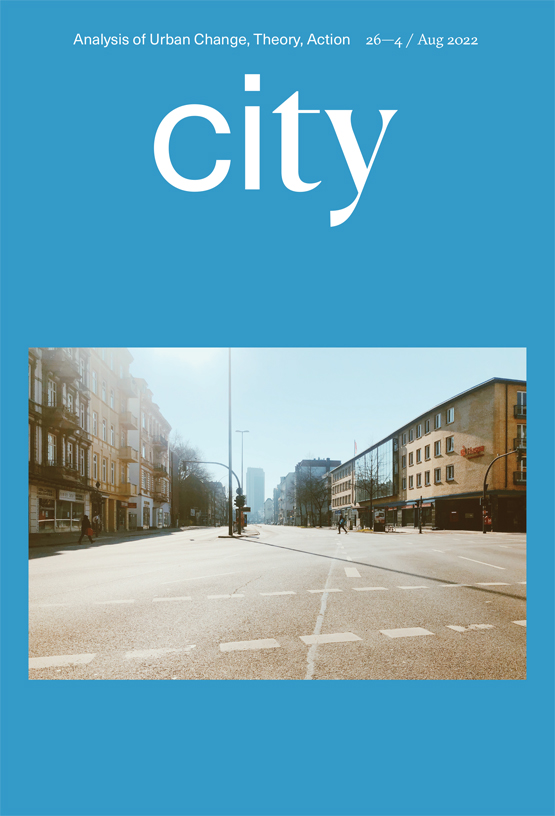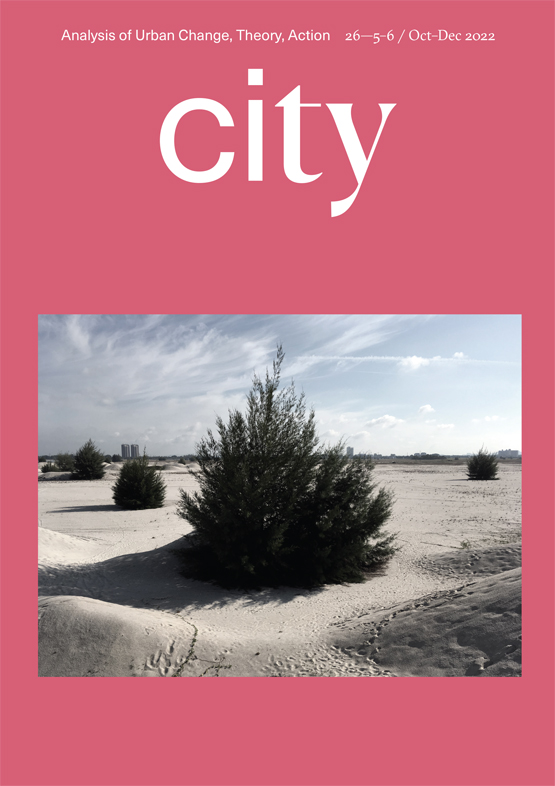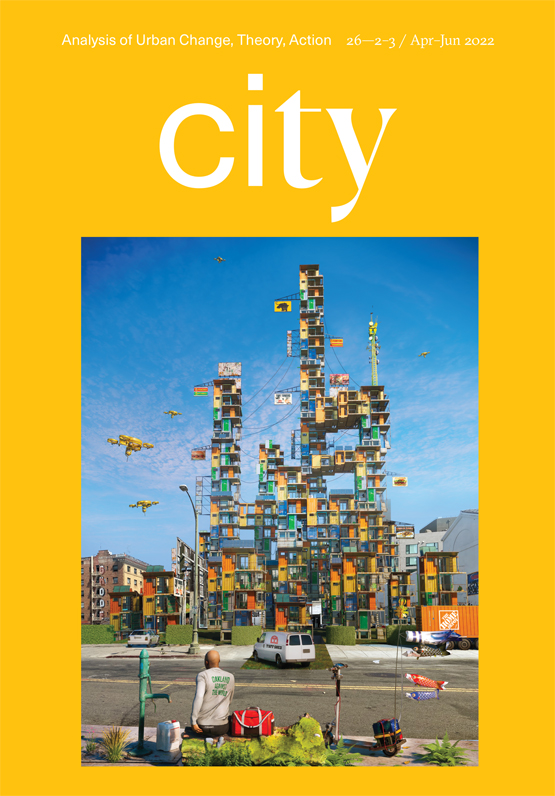founding editor: bob caterrall
editor: city editors
editorial: Tired city: on the politics of urban exhaustion, – david madden
We at City are tired. Everyone we know is tired. Exhaustion has become one of the fundamental features of urban life. When an experience becomes sufficiently widespread, it makes sense to ask if it’s an indicator of a deeper condition. Considering how cities and economies work today, there is no doubt that fatigue is not a temporary symptom. It’s not (only) something you’re feeling because you just had covid for the second time. Rather, after more than two years of the pandemic, more than thirteen years since the global financial crisis, and more than four decades of neoliberalism, exhaustion is now deeply rooted within contemporary urbanisation.
Urban exhaustion results from the febrile rhythm and hastening speed of today’s crisis-prone, globalised, financialised capitalism. Theorists like Judy Wajcman (2014) and Hartmut Rosa (2013) have argued that the world is undergoing acceleration, forced to follow a pace set by the likes of fibre-optic communication, satellite transmission and high-frequency trading. Financialised capitalism is not only fast—it’s also restless and relentless, marked by a persistent, undifferentiated planet-spanning temporality that brings about what the critic Jonathan Crary (2013, 8) calls ‘a generalized inscription of human life into duration without breaks, defined by a principle of continuous functioning. It is a time that no longer passes, beyond clock time.’ There is no down time anymore. Business is always open. Ever larger areas of economic and social life are pegged to this unceasing, undifferentiated tempo. It’s no wonder that everyone’s tired.
In this economic order, any non-productive or autonomous time is steadily eroded. Different economic classes clearly experience this erosion differently, yet the overall direction of change is similar. Marx had already observed in Victorian industry the imperative towards the intensification of labour and the ‘filling-up of the pores of the working day’ (Marx [1867] 1976, 534). But no 19th-century factory floor can match the digital Taylorism of today, when round-the-clock operations like fulfillment centres and delivery companies use geocoded surveillance systems to track workers’ every movement and count every toilet break. Middle-class workers possess more autonomy, but they still face digital tracking, intensifying productivity metrics and an increasingly unbounded working day. The pandemic exacerbated all of these trends. For some, working from home now entails a distended workday that sprawls into nights, mornings, weekends, mealtimes, holidays, and sick leave. For others, including many who are classified as essential workers, precarity compels them to keep their weary bodies performing through illness, consecutive shifts, uncertain staffing, extended hours and multiple jobs, all while real wages are falling.
If the pace and conditions of labour in extremely late capitalism are basically guaranteed to leave workers exhausted, the spaces and institutional structures of the 21st-century city are equally wearying. Urban life in its current configuration seems almost intentionally designed to be draining. Broken public systems, curtailed municipal services, hostile architecture and under-developed infrastructure stunted by years of austerity make everyday life in the city far more onerous than it needs to be. In British cities, manifestly anti-social architectural paradigms like Secure By Design have been used to justify the removal of public benches, tables and other gathering places that support non-instrumental convivial life. Structures for collective care—such as council housing, community health clinics, youth centres, public parks, and communal gardens—are under threat of closure and redevelopment towards more profitable uses. The broader crisis of social reproduction (Bhattacharya 2017) is reflected in an urban landscape where the spaces for repose have been undermined or colonised. Rai, Hoskyns, and Thomas (2014, 86) define what they call ‘depletion through social reproduction’ as what happens ‘when there is a critical gap between the outflows—domestic, affective and reproductive—and the inflows that sustain their health and well-being.’ Workers keep the economy going, but at the expense of their own welfare, in effect subsidising financialised capitalism with their own fatigue. Cities today are filled with talk of regeneration and renewal, but for the people who actually live in them, life is becoming ever more depleting.
In neighbourhoods that have been plagued by austerity, overworked activists are often picking up the slack through mutual aid groups, soup kitchens, community spaces and other forms of self-organised social infrastructure. But this also takes a toll. I recently visited Govanhill Baths Community Trust, an extensive network of arts, environment and communal well-being projects in Glasgow that was established following an occupation and grassroots campaign. Govanhill Baths is an example of self-organised solidarity plugging the gaps left by the retreating municipal state. But a long-time activist and organiser there remarked, ‘We shouldn’t need to be doing this. We’re tired.’ This kind of systemically-induced fatigue is one form through which the violence of state abandonment is experienced.
Exhaustion is, of course, unequally distributed. It is less likely to afflict the wealthy, the white, the well-housed, the native born, the able-bodied and others whose resources allow them to purchase domestic assistance and pay for missing municipal services. At the same time, for exploited and subordinated groups, the inequality and precarity of uneven urbanisation creates surplus exhaustion. Working-class and poor households are more likely to be wearied by long commutes and frequent moves. For the growing numbers of people forced into homelessness, urban life is increasingly a time without rest, as jurisdictions in the US and elsewhere criminalise camping, squatting, and sleeping in cars. The persistence of interpersonal and institutional violence against women, people of colour and other minoritised city dwellers is also oppressively tiring. All of these forms of exhaustion can fuel resistance. But activists’ burnout also makes organising more difficult. In their recent paper in City on ‘The Politics of Exhaustion’, Akwugo Emejulu and Leah Bassel (2020, 400) argue that ‘“I’m exhausted” is a familiar refrain among women of colour activists in cities across Europe and North America’, an affective state so common that ‘Exhaustion operates quite literally as a structure of feeling of mutual recognition.’ Tiredness is not only a cause and consequence of mobilisation. Exhaustion is also a form of rule. The powerful know that they can weaponise the general condition of fatigue, thereby maintaining the status quo by wearing down the opposition. Cities today are replete with examples of labour unions, anti-racist activists, tenants’ campaigns, and other social movements that are locked in struggles that have been intentionally drawn out. There is a politics to urban exhaustion because it is shaped by—and in turn shapes—power relations, urban agency, and unequal rights to the city.
to this editorial in full, please click here





